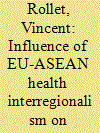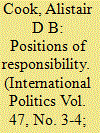| Srl | Item |
| 1 |
ID:
154428


|
|
|
|
|
| Summary/Abstract |
Over the past decade, remarkable and sustainable progresses have been made in the Association of Southeast Asian Nations (ASEAN) region in the domain of communicable disease control. Nevertheless, communicable diseases remain an important public health issue in the region. In December 2009, within the framework of its Regional Programming for Asia (2007–2013), the European Union (EU) launched a Regional Program on Highly Pathogenic and Emerging Diseases (HPED) in Asia. This 4-year interregional cooperation initiative aimed at enable ASEAN to control zoonoses and to improve pandemic preparedness in the region. Assessing this interregional initiative, the main objective of this paper is to shed light on the nature and functions of health interregionalism between Asia and Europe and its influence on regional health governance. It concludes that while in the specific context of the EU-ASEAN HPED program, health interregionalism had varied functions and a substantial influence on regional health governance, this initiative did not use the full potential that interregional health mechanism may provide to influence the development of another region or to promote the EU’s specific actorness in regional and global health.
|
|
|
|
|
|
|
|
|
|
|
|
|
|
|
|
| 2 |
ID:
098798


|
|
|
|
|
| Publication |
2010.
|
| Summary/Abstract |
Recent challenges have tested the approaches of both the Association of Southeast Asian Nations (ASEAN) and the European Union (EU) to adequately respond to forced migration in Myanmar. This article provides a comparison between the European sanctions regime and ASEAN's 'constructive engagement' with Myanmar. In the aftermath of Cyclone Nargis, it is ASEAN, along with the United Nations (UN), that has offered an effective mechanism to access populations of concern in Myanmar. This article draws on the experience of the UN High Commission for Refugees on the western border and argues that while the new ASEAN-UN-led mechanism offers a new way to assist people in the delta region, this access is contingent on three constraints: maintenance of personal relations with military decision-makers, continuation of an ASEAN-UN-led mechanism and ongoing funding from donor nations.
|
|
|
|
|
|
|
|
|
|
|
|
|
|
|
|